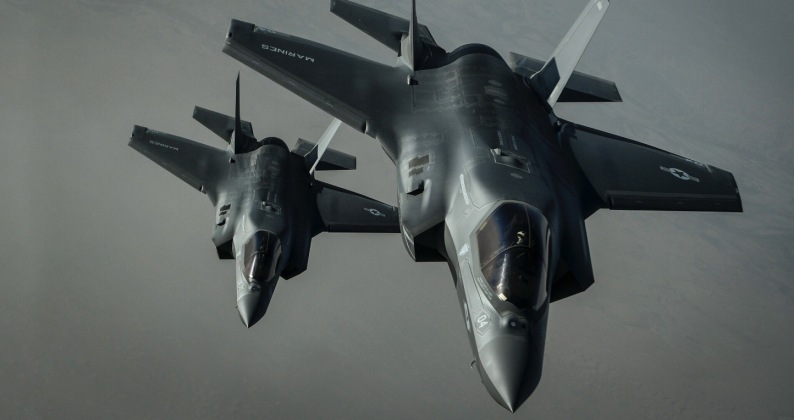News
Obsidian Iceberg: U.S. Marines Continue to Improve ‘Airfield Free’ F-35B Stealth Operations Aimed at China
The U.S. Marine Corps has continued to invest heavily in improving the capabilities of its F-35B stealth fighter units to perform ‘island hopping’ operations in the Western Pacific, with the aircraft’s short takeoff and vertical landing (STOVL) capabilities allowing them to be utilised in unique ways that leave them far less vulnerable to attacks on airfields. The F-35B is by far the most costly fighter in production anywhere in the world, and has a significant poorer combat performance and lower endurance than other F-35 variants as well as higher maintenance requirements. Its ability to land vertically and takeoff from short or makeshift runways, however, is highly prized not only for operations from lighter classes of aircraft carriers such as the America Class ships currently under construction, but also for their ability to utilise austere airfields. As the Marines have placed a greater emphasis on asymmetric operations in East Asia, retiring tanks, artillery and other heavy equipment, and planning to deploy large numbers of mobile missile launchers, the F-35B’s ability to move between very small landing sites could allow it to operate much closer to Chinese territory and make it much more difficult to neutralise. Such landing sites will be more difficult for surveillance assets to identify, and complement the aircraft’s own stealth and sensor fusion capabilities.

A recent series of test events known at as ‘Obsidian Iceberg’ has sought to further improve F-35B ‘island hopping’ and austere airfield operations, with the Operational Test Director of the Marine Corps’ Operational Test and Evaluation Squadron One carrying out the tests, Lieutenant Colonel Robert Guyette, stating regarding their purpose: “It’s about the F-35 executing sustained combat operations from places that, quite honestly, the enemy’s not gonna expect us to be operating from.” Regarding plans to utilise F-35Bs in East Asia, retired U.S. Marine Corps lieutenant colonel David Berke observed as early as 2018: “You can fly the F-35B literally anywhere. If your traditional places of operation are unavailable the F-35B can be there…. Find me 600 feet of flat surface anywhere in the world, and I can land there.” He compared the F-35B to the A-10 Warthog ground attack jet in its ability to operate from short runways or dirt roads, with the Marines potentially able to use their V-22 Osprey and CH-53 helicopters to airlift supplies and set up such makeshift bases quickly. With such operations more recently being termed Expeditionary Advanced Base Operations (EABO), they were described as follows in the 2019 Marine Aviation Plan:
EABO is a future naval operational concept that mitigates peer competitors’ anti-access / area denial capability by creating a more survivable, resilient, and persistent forward- postured force. The EABO concept is designed to re-establish the force credibility required to have a deterrent effect. Using key maritime terrain in the vicinity of close and confined seas… EABO sustains and advances the inside force’s ability to leverage the lethality of the outside force. The EABO concept is comprised of low-signature, mobile, relatively low-cost capabilities operating in expeditionary and temporary locations. These capabilities provide the joint force commander with the ability to target and strike the adversary while also making up the backbone of an active maritime defence-in-depth. EABO provides… sea denial options by using advanced bases to position and operate joint aircraft. All six functions of Marine aviation can be executed through the use of mobile and expeditionary EABs. By using all available basing options, Marine aviation can expand the reach and lethality of the joint force commander.

The use of vertical landing capable fighters for austere airfield operations has been under consideration since the early days of the Cold War, although the performance limitations such aircraft faced compared to those deploying from standard runways meant that this was seldom seen as efficient and such aircraft were commissioned primarily for aircraft carrier operations. The Soviet Yak-41 fighter, which was at an advanced prototype stage when the state’s disintegration collapsed the program, was intended to be the first fighter with a competitive combat performance and vertical landing capabilities. Unlike the F-35B, it was also designed to be capable of vertical takeoffs with a combat load. The F-35B, the development of which benefitted from some technology transfers from the Yak-41 program, has no foreign rivals as a result of the Soviet disintegration, although as by far the world’s largest single engine fighter its weight and high maintenance needs impose some limitations on its practicality for the kind of austere airfield operations envisaged. The viability of Expeditionary Advanced Base Operations using F-35Bs remains highly uncertain, although should it prove effective it could seriously limit adversaries’ ability to cripple American air power by neutralising air bases in a war’s early stages – which is currently considered central to Chinese and North Korean operational planning.












